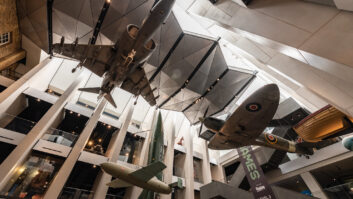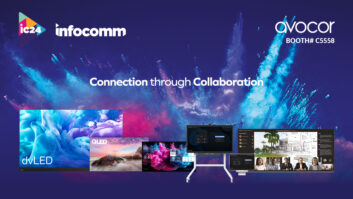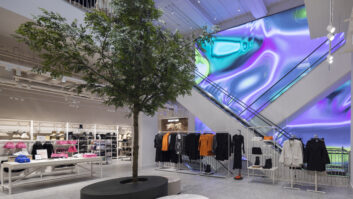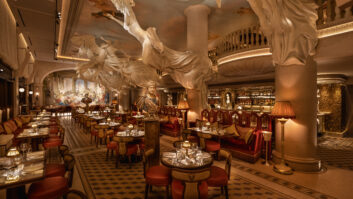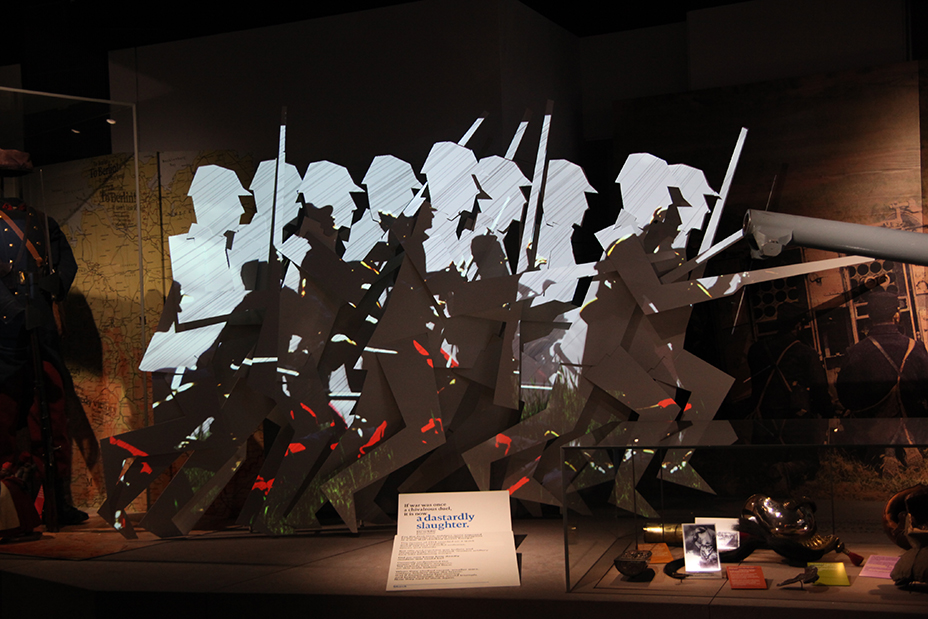
To mark the start of the centenary of the First World War, the Imperial War Museum in London opened a new, permanent First World War Gallery. Steve Montgomery investigates the use of audiovisual technology to absorb and engage visitors of all ages.
The Imperial War Museum (IWM) reopened its doors last year after a £40 million transformation that began in 2010. During the closure, the interior was remodelled to create four gallery floors around a central open atrium capable of displaying large war machines, including aircraft and tanks.
On the centenary of the First World War, the museum created a new permanent gallery dedicated to this conflict. It includes over 1,300 objects from the very small to the very large, encompassing weapons, uniforms and personal items. In a generation in which many no longer have relatives who were alive during fighting, the museum explains not just the war, but the effect it had on people both before and afterwards. “The intention is to bring alive the thoughts of people at the time; from recollections, letters, diaries, all the evidence we have of how people thought about the war in the period before they knew how it would end,” says Laura Clouting, curator at the IWM.
The museum has incorporated new and relevant ways to engage modern audiences. “Visitors can find specific information in over 60 audiovisual displays and hands-on interactive exhibits that illuminate, pace and punctuate the story,” explains James Taylor, lead curator at the museum. “We felt it crucial that visitors should see the conflict through the eyes of those who lived and died during the First World War. The exhibition covers the period 1900 to 1929 and explains where the war came from, how it was fought and how lives were affected after it ended.”
A great deal of that information and experience is conveyed through the use of visual display screens and audio soundscapes. Footage from the IWM’s extensive film library is used to recreate the sights and sounds of soldiers, munitions factory workers and ordinary civilians throughout several themed zones, ranging from Shock, in which visitors come face to face with the terrifying French 75mm field gun, to Deadlock, where they pass through a recreated trench complete with the sound of soldiers’ voices, coloured images and a Sopwith Camel fighter swooping overhead.
A wide range of screens is used, according to the effect and evidence each display was designed to convey, complementing the exhibits rather than taking over for theatrical effect. “With such a wide range of visual material to hand it was possible to incorporate small visual displays among the artefacts to explain their context as well as large videowalls and projected images to fully immerse visitors,” says Hugo Roche, managing director of integrator Sysco. “Individual devices were selected to suit the requirements of each application, whether that was a projector, single large-screen display or multiple videowall as backdrops in zones or 7in, 12in, 17in or 24in screens dispersed among the exhibits themselves. To extend the amount and extent of information available, interactive touchscreens and infrared sensing tables allow visitors to interact and explore topics more deeply.”
Offsite testing
Selection of equipment was made through offsite testing and, in the case of projectors, a shoot-out involving members of the IWM curatorial and museum design teams. Epson EB-G6900 projectors were used, chosen primarily on their ability to deliver a subtle image and their unobtrusive design, which made it simpler to incorporate the technology within the fabric of the building. Large-format NEC V- and X-series professional LCD displays were used to create impact in the Total War zone, showing footage from the five-month-long Battle of the Somme that marked a pivotal point in the war. They were also used to create a 3 x 2 videowall, providing a through-window view of food and munitions factories in Feeding the Front.
Audiovisual content was created by amalgamating CGI, special effects, original footage and, where appropriate, interactive content. “The diversity of content and interactive sequences presented challenges in two areas,” points out Greame Bunyan, associate director of Sysco. “There is a lot of equipment within a small area, so we were necessarily constrained in the types and diversity of equipment selected. Content ranges from new animated sequences and archival still images to original footage on a cross-section of types of small and large, single and multi-display LCD and projectors. This meant that we needed to consider and select the most appropriate source players, including BrightSign media players, 7th Sense servers and Dataton Watchout systems with Medialon Show Control.” Even Raspberry Pi players are used within some exhibits to feed custom Black Cat panels.
Setting the mood
Perhaps the most striking and innovative aspect, though, is the use of soundtracks in each zone and an all-encompassing soundscape throughout the museum. Ramon De Marco, founder of Idee und Klang, the audio scenography designer that successfully conceived the museum’s audio presence, explains: “There was a need to isolate the individual audio reproductions within each zone; to stop the sound bleeding between them. These are necessarily sharp and loud as they depict exploding shells, gunfire and aircraft intermingled with human voices. The approach we took was to create a continuously changing weather background throughout the gallery which prevented sounds from one zone encroaching on another.”
Another innovative concept is the AROS philosophy developed by Idee und Klang. “AROS, Acousmatic Room Orchestration System, creates a mood in each zone, rather than just illustrating the background noise. We effectively use individual speakers as instruments, each one playing an isolated sound in the same way that a violin or cello would in an orchestra. The combined effect is the creation of a sound symphony, built from identifiable, relevant sounds, and because there is an element of randomisation in playback the ‘music’ is always changing.”
To create the desired effect, De Marco and his team needed to select speakers with specific sound characteristics – a challenge that was compounded by not being able to examine the acoustics of the museum before installation. Working with Sysco, they built full-sized replica spaces at the company’s HQ in Switzerland and tested a range of speakers and transducers to simulate the effect. “The museum team visited and together we listened to, and decided on, around 50-60% of the equipment that would be deployed to create the spatial effects that would best match the atmosphere desired. Final mixing, speaker positioning and the direction they faced were then completed during installation in the museum.”
“We selected mainly Fohhn speakers, some Tannoy, JBL, Panphonics and Solid Drive speakers with Powersoft amps with inbuilt DSPs and Ovation audio servers as best suited to the constricted spaces,” points out Bunyan. “The result is a musical, in some cases melodic, sound that is constantly changing, delivering identifiable sounds from discrete locations in contrast to a cacophony of background noise.”
The four-year renovation project has resulted in an experience that respects and treats war in a sensitive manner, providing, through the use of technology and creativity, a way of engaging visitors with no personal or first-hand knowledge of war, and it will continue to do so for decades to come.
www.7thsensedesign.com
www.blkkat.com
www.brightsign.biz
www.dataton.com
www.epson.co.uk
www.fohhn.com
www.gpegint.com
www.harman.com
www.ideeundklang.com
www.iwm.org.uk
www.iiyama.com
www.medialon.com
www.nec-display-solutions.com
www.panphonics.com
www.powersoft-audio.com
www.raspberrypi.org
www.soliddrive.com
www.stemmer-imaging.co.uk
www.symetrix.co
www.syscoav.co.uk
www.tannoy.com
